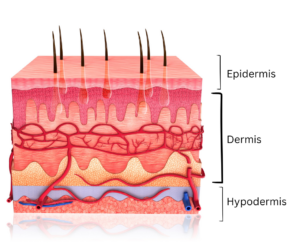
Learn Skin Anatomy, structure & functions!

The Skin is a complex organ covering the entire body surface as a flexible shield; it is one of the body’s largest and heaviest organs and has a total area of about 20 square feet.
It weighs between 3.5-5 kg in adults. Skin accounts for about 16 percent of a person’s total body weight.
Our Skin’s most important job is to protect the inside of the body from the environment, but there is much more to the skin than that.
An average square inch of skin contains 650 sweat glands, 20 blood vessels, and more than 1,000 nerve endings.
Humans shed around 500 million skin cells each day. In fact, the outermost parts of the epidermis consist of 20–30 layers of dead cells.
The Skin is made up of water, protein, fats, and minerals.
It comprises about 70% water, 25% proteins, and 3% lipids. The remainder includes minerals, nucleic acids, glycosamines, proteoglycans, and numerous other chemicals.
There are various functions of the Skin, like:
- The skin is the body’s initial barrier against pathogens, UV light, chemicals, and mechanical or thermal injury.
- Prevents loss of moisture; it controls water loss by preventing water from escaping by evaporation.
- Reduces harmful effects of UV radiation; Skin creates a radiation barrier against UV light – by producing the melanin pigment by the melanocytes in the basal layer.
- Skin detects different sensations like heat, cold, pressure, contact, and pain.
- Helps regulate temperature- The Skin is responsible for maintaining the body temperature at approximately 37°C. It helps with thermoregulation by producing sweat and dilating blood vessels, keeping the body cool. “Goosebumps” and blood vessel constriction help people retain heat.
- Skin acts as an immune organ to detect infections. Langerhans cells in the skin are part of the immune system.
- Production of vitamin D with the assistance of UV light from the sun.
The Skin comprises three primary layers: the epidermis, the dermis, and the hypodermis.
The epidermis “epi” comes from the Greek meaning “over” or “upon.
This is the top waterproof elastic layer on the Skin, which you can touch & see.
The epidermis contains no blood vessels, and cells in the deepest layers are nourished almost exclusively by diffused oxygen from the surrounding air and, to a lesser degree, by blood capillaries extending to the outer layers of the dermis.
The primary cells that make up the epidermis are Merkel cells, keratinocytes, melanocytes, and Langerhans cells.
Keratinocytes are the most common type of cells within the epidermis. They are a barrier against bacteria, parasites, fungi, viruses, heat, ultraviolet (UV) rays, and water loss.
The color of the skin comes from a pigment called melanin, produced by melanocytes, which are found in the epidermis and protect the skin from UV rays.
What does the Epidermis layer of Skin do?
- Acts as a protective barrier: The epidermis keeps bacteria and germs from entering your body and bloodstream and causing infections. It also protects against rain, sun, and other elements.
- Makes new Skin: The epidermis continually makes new skin cells. These new cells replace the 40,000 old skin cells your body sheds daily. You have new Skin every 30 days.
- Protects your body: Langerhans cells in the epidermis are part of the body’s immune system. They help fight off germs and infections hence protecting our bodies.
- Provides skin color: The epidermis contains melanin, the pigment that gives Skin its color. The amount of melanin you have determines the color of your Skin, hair, and eyes. People who make more melanin have darker Skin and may tan more quickly.
What does the Dermis (middle layer of Skin) do?
The dermis makes up 90% of the Skin’s thickness, which is the middle layer of the Skin.
- Has collagen and elastin: Collagen is a protein that makes skin cells strong and resilient. Another protein found in the dermis is elastin, which keeps Skin flexible. It also helps stretched Skin regain its shape.
- Grows hair: The roots of hair follicles attach to the dermis.
- Keeps you in touch: Nerves in the dermis tell you when something is too hot to touch, itchy, or super soft. These nerve receptors also help you feel pain.
- Makes oil: Oil glands in the dermis help keep the Skin soft and smooth. Oil also prevents your Skin from absorbing too much water when you swim or get caught in a rainstorm.
- Produces sweat: Sweat glands in the dermis release sweat through skin pores. Sweat helps regulate your body temperature.
- Supplies blood: Blood vessels in the dermis provide nutrients to the epidermis, keeping the skin layers healthy.
What does the Hypodermis (bottom layer of Skin) do?
The bottom layer of Skin, or Hypodermis, is the fatty layer. The Hypodermis:
- Cushions muscles and bones: Fat in the hypodermis protects muscles and bones from injuries when you fall or are in an accident.
- Has connective tissue: This tissue connects layers of Skin to muscles and bones.
- Helps the nerves and blood vessels: Nerves and blood vessels in the dermis (middle layer) get larger in the hypodermis. These nerves and blood vessels branch out to connect the hypodermis to the rest of the body.
- Regulates body temperature: Fat in the hypodermis keeps you from getting too cold or hot.
So this was all about the layers of the skin.
Let’s learn about Skin Thickness:
The thickness of each layer of the skin varies depending on the body region and is categorized based on the thickness of the epidermal and dermal layers.
Hairless skin is found in the palms of the hands and soles of the feet & it is thickest because the epidermis contains an extra layer, the stratum lucidum, on these parts.
The upper back is considered the thickest based on the thickness of the dermis. Still, it is considered “thin skin” histologically because the epidermal thickness lacks the stratum lucidum layer and is thinner than hairless skin.
The general appearance, elasticity, and other skin qualities can give us insight into the body’s general health… but this is a massive topic, so we will discuss how your skin expresses your inner health in upcoming episodes.
I hope you liked today’s topic about your precious skin!
Don’t forget to like & subscribe to my website and share if you like the content.. this will help others as well to learn about skin and its holistic healing.
